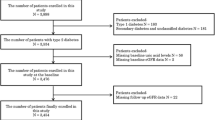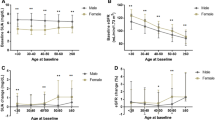Abstract
Aims
Bisphenol A (BPA) is associated with diabetes and cardiovascular diseases. The aim of our study was to evaluate whether serum BPA could predict the progression of chronic kidney disease (CKD) in patients with type 2 diabetes (T2D).
Methods
In this prospective study, a total of 121 patients with T2D and estimated glomerular filtration rate (eGFR) ≥ 60 mL/min/1.73 m2 were followed up for 6 years. The baseline values of serum BPA were measured. Renal function was measured as eGFR calculated by the Chronic Kidney Disease Epidemiology Collaboration creatinine–cystatin C equation. Development of CKD was defined as eGFR < 60 mL/min/1.73 m2 at the last follow-up. Regression models were used to analyze the associations of serum BPA with the change in eGFR and the risk of CKD development.
Results
Baseline serum BPA concentration was 0.40 (0.17, 1.40) ng/mL. Duration of T2D, baseline waist circumference, systolic blood pressure, diastolic blood pressure, fasting plasma glucose, and serum BPA level were significantly negatively associated with the annual change and percentage change in eGFR. After adjusting for clinical factors, baseline serum BPA level had a significant negative association with the annual change in eGFR (β = −0.371, P < 0.001) and percentage change in eGFR (β = −0.391, P = <0.001). Multivariate logistic regression analysis showed that patients with high levels of serum BPA exhibited about a sevenfold increased risk of developing CKD compared to patients with low levels of serum BPA [odds ratio (OR) 6.65 (95 % CI 1.47, 30.04), P = 0.014].
Conclusion
Serum BPA may be a predictor of CKD in patients with T2D.
Similar content being viewed by others
References
Pugliese G (2014) Updating the natural history of diabetic nephropathy. Acta Diabetol 51(6):905–915
Rashid K, Sinha K, Sil PC (2013) An update on oxidative stress-mediated organ pathophysiology. Food Chem Toxicol 62:584–600
vom Saal FS, Welshons WV (2014) Evidence that bisphenol A (BPA) can be accurately measured without contamination in human serum and urine, and that BPA causes numerous hazards from multiple routes of exposure. Mol Cell Endocrinol 398(1–2):101–113
You L, Zhu X, Shrubsole MJ, Fan H, Chen J, Dong J, Hao CM, Dai Q (2011) Renal function, bisphenol A, and alkylphenols: results from the National Health and Nutrition Examination Survey (NHANES 2003–2006). Environ Health Perspect 119(4):527–533
Li M, Bi Y, Qi L, Wang T, Xu M, Huang Y, Xu Y, Chen Y, Lu J, Wang W, Ning G (2012) Exposure to bisphenol A is associated with low-grade albuminuria in Chinese adults. Kidney Int 81(11):1131–1139
Trasande L, Attina TM, Trachtman H (2013) Bisphenol A exposure is associated with low-grade urinary albumin excretion in children of the United States. Kidney Int 83(4):741–748
Gonzalez-Parra E, Herrero JA, Elewa U, Bosch RJ, Arduan AO, Egido J (2013) Bisphenol a in chronic kidney disease. Int J Nephrol 2013:437857
Aekplakorn W, Chailurkit LO, Ongphiphadhanakul B (2015) Relationship of serum bisphenol A with diabetes in the Thai population, National Health Examination Survey IV, 2009. J Diabetes 7(2):240–249
Melzer D, Osborne NJ, Henley WE, Cipelli R, Young A, Money C, McCormack P, Luben R, Khaw KT, Wareham NJ, Galloway TS (2012) Urinary bisphenol A concentration and risk of future coronary artery disease in apparently healthy men and women. Circulation 125(12):1482–1490
Kandaraki E, Chatzigeorgiou A, Livadas S, Palioura E, Economou F, Koutsilieris M, Palimeri S, Panidis D, Diamanti-Kandarakis E (2011) Endocrine disruptors and polycystic ovary syndrome (PCOS): elevated serum levels of bisphenol A in women with PCOS. J Clin Endocrinol Metab 96(3):E480–E484
Inker LA, Schmid CH, Tighiouart H, Eckfeldt JH, Feldman HI, Greene T, Kusek JW, Manzi J, Van Lente F, Zhang YL, Coresh J, Levey AS, Investigators C-E (2012) Estimating glomerular filtration rate from serum creatinine and cystatin C. N Engl J Med 367(1):20–29
Coresh J, Turin TC, Matsushita K, Sang Y, Ballew SH, Appel LJ, Arima H, Chadban SJ, Cirillo M, Djurdjev O, Green JA, Heine GH, Inker LA, Irie F, Ishani A, Ix JH, Kovesdy CP, Marks A, Ohkubo T, Shalev V, Shankar A, Wen CP, de Jong PE, Iseki K, Stengel B, Gansevoort RT, Levey AS, Consortium CKDP (2014) Decline in estimated glomerular filtration rate and subsequent risk of end-stage renal disease and mortality. JAMA 311(24):2518–2531
Kim SS, Song SH, Kim IJ, Jeon YK, Kim BH, Kwak IS, Lee EK, Kim YK (2013) Urinary cystatin C and tubular proteinuria predict progression of diabetic nephropathy. Diabetes Care 36(3):656–661
Rhee EP, Clish CB, Ghorbani A, Larson MG, Elmariah S, McCabe E, Yang Q, Cheng S, Pierce K, Deik A, Souza AL, Farrell L, Domos C, Yeh RW, Palacios I, Rosenfield K, Vasan RS, Florez JC, Wang TJ, Fox CS, Gerszten RE (2013) A combined epidemiologic and metabolomic approach improves CKD prediction. J Am Soc Nephrol 24(8):1330–1338
Yildiz N, Barlas N (2013) Hepatic and renal functions in growing male rats after bisphenol A and octylphenol exposure. Hum Exp Toxicol 32(7):675–686
Olea-Herrero N, Arenas MI, Munoz-Moreno C, Moreno-Gomez-Toledano R, Gonzalez-Santander M, Arribas I, Bosch RJ (2014) Bisphenol-A induces podocytopathy with proteinuria in mice. J Cell Physiol 229(12):2057–2066
Shankar A, Teppala S, Sabanayagam C (2012) Bisphenol A and peripheral arterial disease: results from the NHANES. Environ Health Perspect 120(9):1297–1300
Fan L, Levey AS, Gudnason V, Eiriksdottir G, Andresdottir MB, Gudmundsdottir H, Indridason OS, Palsson R, Mitchell G, Inker LA (2014) Comparing GFR estimating equations using cystatin C and creatinine in elderly individuals. J Am Soc Nephrol. doi:10.1681/ASN.2014060607
Vandenberg LN, Gerona RR, Kannan K, Taylor JA, van Breemen RB, Dickenson CA, Liao C, Yuan Y, Newbold RR, Padmanabhan V, Vom Saal FS, Woodruff TJ (2014) A round robin approach to the analysis of bisphenol A (BPA) in human blood samples. Environ Health 13(1):25. doi:10.1186/1476-069X-13-25
Ohno M, Deguchi F, Izumi K, Ishigaki H, Sarui H, Sasaki A, Segawa T, Yamaki T, Kojima T, Ohashi H (2014) Correlation between renal function and common risk factors for chronic kidney disease in a healthy middle-aged population: a prospective observational 2-year study. PLoS One 9(11):e113263. doi:10.1371/journal.pone.0113263
Pham H, Robinson-Cohen C, Biggs ML, Ix JH, Mukamal KJ, Fried LF, Kestenbaum B, Siscovick DS, de Boer IH (2012) Chronic kidney disease, insulin resistance, and incident diabetes in older adults. Clin J Am Soc Nephrol 7(4):588–594
Zoccali C, Torino C, Tripepi G, Mallamaci F (2012) Assessment of obesity in chronic kidney disease: what is the best measure? Curr Opin Nephrol Hypertens 21(6):641–646
Evans PD, McIntyre NJ, Fluck RJ, McIntyre CW, Taal MW (2012) Anthropomorphic measurements that include central fat distribution are more closely related with key risk factors than BMI in CKD stage 3. PLoS One 7(4):e34699. doi:10.1371/journal.pone.0034699
Anjana RM, Shanthirani CS, Unnikrishnan R, Mugilan P, Amutha A, Nair HD, Subhashini S, Venkatesan U, Ali MK, Ranjani H, Mohan V (2015) Regularity of follow-up, glycemic burden, and risk of microvascular complications in patients with type 2 diabetes: a 9-year follow-up study. Acta Diabetol 52(3):601–609
Song Y, Hauser R, Hu FB, Franke AA, Liu S, Sun Q (2014) Urinary concentrations of bisphenol A and phthalate metabolites and weight change: a prospective investigation in US women. Int J Obes 38(12):1532–1537
Acknowledgments
The authors thank Laboratory of Endocrine and Laboratory of Lipid and Glucose Metabolism, the First Affiliated Hospital of Chongqing Medical University. This research was supported by National Key Clinical Specialties Construction Program of China and National Natural Science Foundation of China Grants 81170751, 81370954, and 81200294. Qifu Li had full access to all of the data in the study and takes responsibility for the integrity of the data and the accuracy of the data analysis.
Author information
Authors and Affiliations
Corresponding author
Ethics declarations
Conflict of interest
Jinbo Hu, Shumin Yang, Yue Wang, Richa Goswami, Chuan Peng, Rufei Gao, Huang Zhou, Yi Zhang, Qingfeng Cheng, Qianna Zhen, and Qifu Li declare that they have no conflict of interest.
Ethical standard
The ethical committee of the First Affiliated Hospital of Chongqing Medical University approved this study. All procedures followed were performed in accordance with the ethical standards laid down in the 1964 Declaration of Helsinki and its later amendments.
Informed consent
Informed consent was obtained from all patients for being included in the study.
Additional information
Managed by Massimo Porta.
Jinbo Hu and Shumin Yang are co-first authors.
Electronic supplementary material
Below is the link to the electronic supplementary material.



Rights and permissions
About this article
Cite this article
Hu, J., Yang, S., Wang, Y. et al. Serum bisphenol A and progression of type 2 diabetic nephropathy: a 6-year prospective study. Acta Diabetol 52, 1135–1141 (2015). https://doi.org/10.1007/s00592-015-0801-5
Received:
Accepted:
Published:
Issue Date:
DOI: https://doi.org/10.1007/s00592-015-0801-5




